
General Cube Philosophy
My general cube philosophy is pretty much the same as every other cube designer out there. The object of cube drafting is to have fun. My philosophy is: "Know Thy Playgroup." What's "fun" to me and my group drives the direction of the cube (both in its inception and its evolution), as it should for all other designers. There are a hundred questions you have to ask yourself when you sit down to build a cube, like:
- How big should I make my cube?
- Should I build a "standard" cube or a themed cube of some kind?
- What type of environment am I trying to create?
- What types of decks and archetypes am I going to support?
- Am I going to allow the Power 9? Portal cards? Un- cards?
- Am I going to create a "banned" list for the cube for any reason? If so, what are those reasons?
- How good do I want to make aggro? Mid-range? Control?
- Am I going to include cards for nostalgia's sake?
- How important is balance?
- Should I run the same number of cards of each color?
- How many artifacts and lands should I use?
- Should I balance my gold section between the color combinations?
- How strict should the balance become?
- Do I value balance over power? What about balance/power over fun?
...And the list goes on and on. But the answer is the same for all of those questions: it's whatever me and my playgroup will have the most fun with.
This philosophy introduction is going to go over some of those questions, and provide the reasons why my group opts to use the cards we do. There is no "right cube" or "wrong cube," unless of course the cube isn't matching up with the philosophy of the cube designer and his or her playgroup. When the cube conflicts with those philosophies, it can be fixed by re-evaluating some of the questions above and those discussed in further detail below.
Cube Design Philosophy
The basic design question: What kind of cube do I want to make? Do I want a traditional cube (powerful cards for standard drafting and sealed)? Do I want a themed cube? Do I want a commons-only cube or a common/uncommon cube? Do I want a cube with only old cards? Only new cards? Maybe a cube that caters particularly to multiplayer play? There are many options to choose from, but after building two "themed" cubes myself (one with only classic cards and one only modern cards) I decided that merging the two cubes together and simply using the most powerful cards fit the philosophies of me and my playgroup better (which is, again, the cardinal rule). We wanted a cube with all the most powerful cards, one that enables aggressive decks and controlling decks both, and can function well doing drafts, sealed deck, or any other variant format we want to play. That's what we wanted to build.
After deciding what kind of cube to make: How big should I make the cube? After managing cubes of all different types and sizes, I decided on a 500-card cube. We decided on this number for a few reasons. First off, it covers the basic number of cards needed to run a standard eight-player draft or four-player sealed pod (360 cards, which should be considered the minimum cube size). But running a 360-card cube had some issues that my playgroup ran into. First and foremost, it lacked variety. We didn't want the entire cube to wind up at the draft table, or the entire cube being divided up in four sealed decks. We wanted to be able to run back-to-back drafts and have some variation in our deck results. Also, we found that 360-card cubes "pigeonhole" the archetypes too much. With the cards you've got available, there's a smaller number of competitive draftable archetypes. Whereas with a cube that's a little bigger, the draft can take players into aggro, mid-range, or control, in any of the colors, archetypes, themes, or combinations therein. Secondly, we found that 500 cards was the perfect balance between "cube staples" and "fringe cards" keeping the power-level right where we wanted it. Our playgroup found that the 500-card cube had just the right number of cards to keep all the amazing cards available, and keep all the chaff out. But really, the question you should ask yourself here is: How many people will be playing the cube? If you're going to draft with only two people all the time, you could probably build a 360 card cube and not have too much of a problem with variation. But even then, two people playing cube sealed will use up half of the cube cards. With my 500-card cube, I can have six people drafting by the time I use up over half of my cube cards, and can run an eight-person draft with a good amount of variation between drafts. People that want to run two eight-person draft pods from the same cube will have to make it a minimum of 720 cards (and up, to increase variety as needed). Some cubes even peak over 900 or even 1000 cards, but that was just too big for our group.
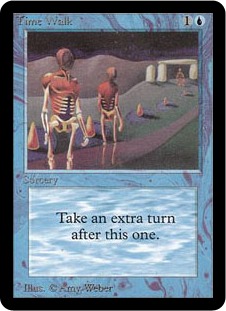
I wanna play too...
The "power versus no power" debate leads directly into the next series of questions we asked about cube design: Am I going to create a "banned" list for my cube? The answer was an enthusiastic NO. Our philosophy of "powerful broken Magic is fun" lead us towards not banning any cards for any reasons whatsoever. The only two reasons a card doesn't make it into the cube are that it either isn't good enough, or it isn't needed. That's it. Some players consider cards like Winter Orb and Moat to be "un-fun" but our playgroup feels quite the opposite. Moat is a control card that needs to be built around, and aggro has ways of removing enchantments, ignoring it with flying creatures, or dealing direct damage to the Moat player. It's been a
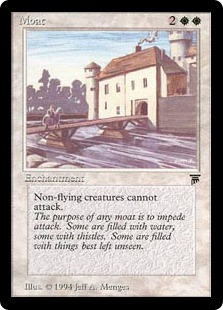
Don't hate me because I'm beautiful!
The next few decisions were all about personal taste. Include Unglued and Unhinged cards or no? Include Portal cards or no? We decided no on both. Not for reasons of balance or power, but just from personal taste. We dislike the Unglued cards because they don't really adhere to the rest of Magic's design parameters, and we decided against Portal cards because for the majority of my Magic playing career, Portal cards weren't legal, and they don't really feel like "real" Magic cards to me. There are some powerful cube cards out there in the Portal universe (about eight or so I'd like to include in this list, namely Ravages of War and Rolling Earthquake). Portal is a lot more likely to make an appearance in my cube in the future sometime, whereas I'm pretty positive the Un- cards will stay out forever.
Now once we've determined what cards are legal, we had to decide if there would be any types of cards excluded from the cube. What level of "narrow" cards are to be included? We already decided not to "ban" cards, but there are certainly some cards that simply don't belong. Generally speaking, the best of the cube cards are going to be both powerful and versatile because they see play in the most decks. We decided
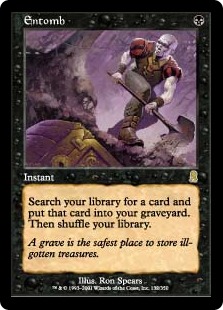
Not as narrow as it looks.
Once we knew what types of cards we were looking for we had to decide how to properly balance the cube. How balanced does the cube need to be? Well, the answer is pretty darn balanced, but not overly balanced to the point where it has an effect on the quality of the cards (for example, we balance colors and draft opportunities, but not the converted mana costs of each individual color). We include the same number of white cards as we do blue cards, and the same number of cards as we do cards (to make sure that all colors have the same chance of drafting the tools they require). We don't have the same number of 2CC cards in black as we do in red, and so forth. Some colors (like blue) will have a higher converted mana cost than other colors (like red) due to the nature of the color. Red is more aggressive than blue, and therefore the cards will be cheaper, and the ACMC (average converted mana cost) will be lower. The ACMC is not the end-all for cube balance, but it is a nice tool to have available to determine which way the cube tends to "lean," so to speak. A typical cube will have an ACMC of 3.0, say. My cube is a little more aggressive, and lands in the 2.9 area, and cubes that are a little more control oriented may land somewhere in the 3.1 region. If you're over 3.2, you may want to look at trimming the fat and adding in some more low casting cost cards to help support aggro. To determine the cube's ACMC, put the whole list into a spreadsheet to organize what you've got in there, and then put the converted mana cost into the cell next to the name. That column will give you the cube's ACMC. An example of a change that could result in lowering the ACMC is removing something like Twilight Shepherd and adding in another Savannah Lions clone (like Elite Vanguard if you're not already using it).
Well, that's fine and good for balancing the mana costs, but: Should I balance the colors evenly? What about gold? Personally, I'm a big supporter of even color distribution for the cube. I think that the cube should have the same number of white cards in it as red cards, for example, and that a player drafting green/white should have the same number of cards available to draft as someone playing red/blue. And so in my cube, I use the same number of cards in each color, and the same number of gold cards in each combination. My 500-card cube is divided up as follows: 65 cards of each color, 65 artifacts, 45 gold cards, and 65 lands. Why so many more lands and so little gold? I'll touch on that more later in the "other points of interest" section of this article. For me and my playgroup, our philosophy was: "Why should one color or color combination have more opportunities to draft the cards it needs than any other?" And that's why we opted to balance everything evenly (or as close to evenly as we could).

This really plays like a red/green card.
Now we've decided what cards are allowed and where they should go. It's time to determine what cards go in.
Archetype Support Philosophy
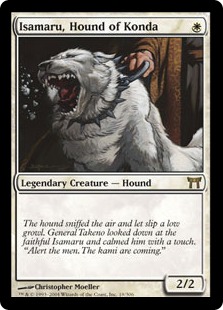
Use me. And every card like me.
Draft Example
I've got 25 aggro creatures and 25 control creatures in the same draft.
~ How many control decks can I make? Five? Six? More?
~ How many aggro decks can I make? Two? Maybe?
Even numbers create uneven drafts. Use more aggro to "balance" the draft.
I've got 25 aggro creatures and 25 control creatures in the same draft.
~ How many control decks can I make? Five? Six? More?
~ How many aggro decks can I make? Two? Maybe?
Even numbers create uneven drafts. Use more aggro to "balance" the draft.
Is there a good way to determine if I've got enough aggro support? Of course there is. The best way (and the only sure way) is to playtest the cube. If you've got six drafters, and two end up in hard aggro, two end up in some sort of mid-range deck, and the other two are playing dedicated control, your job is done. But for those cube designers that don't have a whole lot of time to playtest and would like to tinker with the balance in between cube sessions, I've developed a "pointing system" that I use to take a look at the rough numbers. Basically, each creature in the cube that is intended for aggro is "pointed" as a 2/0. Each creature that is mid-range oriented or is equally playable in both aggro and control is a 1/1. Each creature that is a control-only creature is an 0/2. Assign points to all the creatures in the cube and add them up. Your overall ratio of the creatures in the five main colors should be 2:1. If you have a perfect 3:2:1 ratio of aggro/mid-range/control (as discussed above) this will come out to a 2:1 perfectly. (3 aggro creatures = 6/0; 2 equal creatures = 2/2; 1 control creature = 0/2... overall 8:4, or 2:1). This is not the "end all" for creature balance by any means, but it is a cool tool to use when determining if you've got "enough" aggro creatures and don't have extensive playtest time.
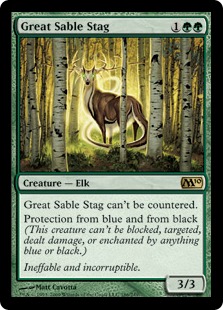
Aggro that fits in mid-range.
Well, you may be saying, that's fine for the creatures, but how do you balance the spells? The spells are even easier to balance. The number one rule is to maximize the number of spells that can be used by all three theaters. What spells does every deck want? Removal, utility, burn... these things are valuable to every single deck that can be constructed. If you make sure that the majority (over 50%) of the spells in each section can be used by aggro and control both, the rest of the spell section is just tinkering. After a few drafts, you may find that you have too many Wrath effects (like Rout and Marshal Coup) or sweeper effects (like Earthquake and Starstorm), and you want to add in more disruption (like Duress and Molten Rain) and spot removal (like Oblivion Ring and Swords to Plowshares) so that all decks have enough spells and not just control. Or you could find the exact opposite.
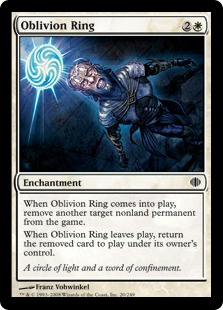
Use spells that go in every deck.
Once you've got aggro and control balanced (mid-range will pretty much fall into line on its own, remember) it's now up to deciding what major deck-types and archetypes you want to support in each color. We all know that you want to add control cards to the colors that support control (Wrath of God, Counterspell) and aggro cards to the colors that support aggro (Isamaru, Hound of Konda and Goblin Guide) but: Which colors should focus on what? How much support should I use for each theater in each respective color? These questions are better answered by the goals of each individual cube designer. For my cube, I decided to base the divided support off of the colors' natural strengths. White, for example, has a lot of aggro and control support both. Blue has the majority of the control support, but very little aggro. Red is almost entirely aggro, but with a splash of control support too. Green is a very mid-range color, due to the quality of the 3-5CC creatures, the plethora of ramp, and all of the great utility cards, so green's focus is on mid-range. And black dabbles in a bit of everything, it has good support cards for all three theaters, so that's what it does. I have a "color summary" at the top of each color section that outlines the themes of the colors and the amount of support dedicated to each theater (10 total points divided between aggro, mid-range and control). White, for example, is a 5:1:4 with most of the support divided between aggro and control, and leaving mid-range as a combination of the two, providing very little "mid-range exclusive" support. Whereas blue is a 1:2:7, being almost completely dominated by control (blue's real strength). Find what colors are good with what respective theaters, and divide up the support to make equally draftable decks from each type.
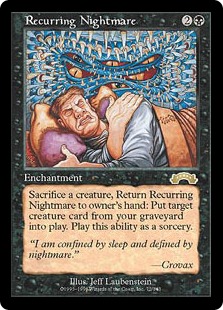
Reanimator is a great cube archetype.
Other Points of Interest
A lot of people have been trying to pinpoint what it is that makes a card good for the cube. Is it just a pile of inherently "good" cards? Is it a collection of all the "best" cards from other formats? How do I evaluate cards to determine if they're good for the cube? I can tell you that this isn't something that comes naturally to everybody. The most common mistake (especially for newer cubers) is trying to transfer their knowledge base from other formats and apply it to the cube. The cardinal rule is this: A

Remember me? Leave me out.
Okay, so cards that are intrinsically good and cards that fit the cube's themes have a shot of making it in. How do you decide which ones ultimately make the cut? What are the most important qualities to look for? The two main qualities to look for are efficiency and flexibility. When I have five creatures competing for three spots, the three that are the most efficiently costed and the three that will make it into the most decks are the ones I
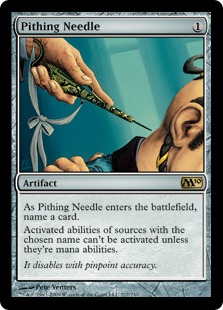
This does a whole lot, for very little.
How much basic Magic theory can be applied to the cube? Don't forget the fundamentals. Card advantage, tempo advantage, and resource advantage are all still very important concepts to understand and remember. Cube cards really should do one of these three things. Creatures that function as spells are probably the best way to generate your card advantage in the cube, because cube games are typically decided through combat. Nekrataal and Kor Sanctifiers are better than the spells that are strapped onto them because they're providing card advantage (and win conditions) at the same time. Tempo advantage is still important, too, as cards like Force of Will and Fireblast are still great cards, despite their card disadvantage. Don't forget about the resource advantage too. Using cheaper cards to solve your opponent's expensive cards is a great way to out-resource your opponent. 6+ casting cost creatures that provide no effect if Terminated don't belong in the cube (they should all have an effect that generates card advantage or have haste/protection or something). Make sure you're guaranteeing yourself at least some value from every card you play.
There are some very simple changes that incipient-phase cubes can undergo that will dramatically improve their overall performance. How can I increase the overall playability of the cube? Reduce the number of gold cards in the cube. I was amazed at how much a moderate reduction in my gold section improved the pack and deck quality. Gold cards naturally go against one of the two most important factors for cube card selection: flexibility. Gold cards go in decks that include their colors, and that's it. They're efficiently costed, for sure, but the restriction of their applications kills their flexibility. I run less than 10% gold cards in my cube. That means that each pack will contain one or maybe two gold cards at most. Gold cards do one of two things if there are too many of them. They either table around the draft and sit in the undrafted cards, or
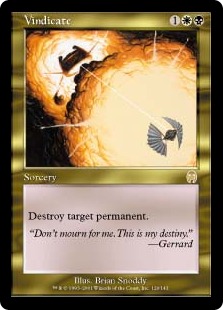
Gold cards should be amazing.
Remember that the most important factor to design is making sure that you're building what you and your playgroup want. Live by the maxim:
KNOW THY PLAYGROUP
It's no use to build a cube that you and your group don't enjoy drafting. But if you're like me (and my playgroup), we wanted to build a cube that contained the best cards and could support both drafts and sealed for our average number of payers. I hope this philosophy introduction was helpful in seeing why my cube is designed the way it is. This was the philosophy I used when designing my cube, and I hope there's at least some information in here that cube designers of all experience levels can use. Make sure to go right from here to my cube thread, so you can look at my color summaries and peruse the cube list. I've got photos of the cube too. Here's the link: http://forums.mtgsalvation.com/showthread.php?t=198041[/URL">MY CUBE.
You can comment on my cube thread, too, instead of just on this article's thread. Thanks for reading!
-
View User Profile
-
Send Message
Posted Aug 4, 2020I am not a big fan of artifacts and non-basic/utility lands, however it seems they fill many holes and gaps in the cube design.
Any special recommendation for some types of artifacts/lands that should be avoided in a cube?
-
View User Profile
-
Send Message
Posted Feb 1, 2021As far as artifacts and lands to avoid, there's not much. I mean, as long as you guys have fun with the cards and the cube is an enjoyable experience, you're doing it right. I would caution against overdoing lands that enter the battlefield tapped though, if you want aggressive decks to be playable in more than one color.
Cheers, and happy cubing!
-
View User Profile
-
Send Message
Posted Jan 25, 2019One question: I know the ACMC of 3 is a rule of thumb, but I wonder if that value you are giving includes lands. Currently my cube sits at 3.26 ACMC excluding lands and 2.84 with land.
Great work, thanks for the thoughtful breakdown.
-
View User Profile
-
Send Message
Posted Jan 25, 2019Land is not included when determining your ACMC. But other cards, like Force of Will, might beb considered a 5 if you use their printed costs, but are actually a 0 in practice. Make sure you adjust your CMCs to what their expected costs are when calculating things. And all cards that are truly variable can get factored in as true X's, which neither help nor hurt your curve.
Cheers, and happy cubing!